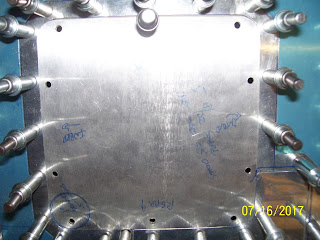Online course from King Schools to renew my CFI certificate - Completed after 2 weeks
Medical renewal due by the end of August - In Progress
Niece's Wedding on August 18
Preparation for upcoming hunting trip on the Labor Day weekend
And so on
More about the medical and the Oshkosh trip later on. Best way to sum it all up is "BEST AIRVENTURE EVER!!!!!"
Anyway, back to building airplanes. I was able to do a little bit more fine tuning of the fit of the metal access plates after completing the rough cut of the new access panel hole. This next pic appears to be a fitting of both panel plates. Also note that I have the SafeAir mounting bracket installed over the new panel cover and the filler plate. I think this was prep for drilling out the screw holes with a #21 drill bit per instructions to prepare for the dimpled #8 screw hole. I also think I was trying to visualize the layout of the mounting bracket compared to the filler plate.
Next is a close up showing the fit between the two plates after drilling all the holes using the mounting bracket as the template:
And another shot after doing some serious filing and sanding of the filler plate edges, especially the radius where it fits up against the lower right corner of the new access plate:
This next one is a bit hard to see, but the gold #30 clecoes have been replaced by the larger black 5/32" clecoes after enlarging the #30 screw holes to #19:
And the next one with the cover plate intalled again to recheck the fit after the larger screw holes were drilled:
And the next with most of the clecoes removed to show the larger holes now drilled into the cover plate AND the subskin:
And finally the subskin/mounting flange with the access plate removed showing the clearance of the new larger screw holes and the mounting area of the subskin.
That last pic above also shows how much smoother the edges of the cutout are. I spent significant amount of time filing and sanding the edges down. I am not quite finished with them but they are very close.
Now for the dire news......
I spent a very large amount of time reviewing AC43.13 and another source book for airplane builders trying to answer sme very straight forward questions:
1. With my current situation on the bottom part of the leading, how many rivets do I use to permanently attach the cover plate to the old access hole?
2. What do I have to do with the subskin to ensure that this mod has not:
a. Added more strength than required or desired to the area than originally designed?
b. ensure that the correct amount of support has been added to the entire area to compensate for the loss of strength in the area due to the extra hole in the bottom of the skin.
If you think you can take any of this lightly you are sadly mistaken. You cannot build this structure too strong or too weak, or the results may be disastrous. AC 43.13 contains information about accepted methods to repair metal (Chapter 4). Unfortunately they only discuss applying a "patch" to a torn or damaged area of the skin.This is not really a tear or damage, but a previously fabricated area of the skin that was cutout. It has more than adequate support to attach it to the subskin, If I apply certain formulas that the book provides to determine the number of rivets, it would require a very large number of rivets. So I am now involved in yet another issue of trying to figure out the accepted method to attach the filler plate. I may even need to seek the advice of a DAR that is knowlegable in metal and structural repair to get proper advice on how to address this. What a mess I have created.
I haven't even got to the best part yet. With all the drilling and re-drilling of rivet holes into the LE skin, I have managed to wallow out several holes in critical areas near the extreme LE of the first Rib. These may even be too large for me to attempt to use an "oops" rivet. While at Airventure I got some input from Mike at Cleaveland Tools after explaining my problem, and he said that if the holes are larger than #36 or so then I may not be able to use the #40 dimple die to set the dimple in the hole. Many of the holes appear to be larger than that. The problem is that the dimple will enlarge the hole a little bit, so if it is already too large, well, you get the idea.
So because of that alone, I may have to abandon this whole mess and buy a new LE skin and ribs. This is the part that you dread when you attempt to do a mod. You think you have it all figured out, but you find out very quickly that metal is not as forgiving as other materials. I think I will seek out a technical counselor at this point and see what they think. Personally I am about ready to abandon this whole idea so I can build the thing and get it flying. Months and months of wasted time and energy.....








No comments:
Post a Comment